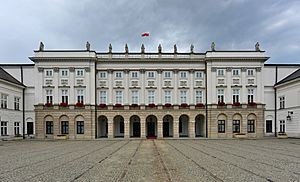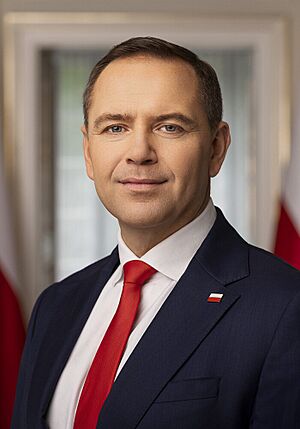President of Poland facts for kids
Quick facts for kids President of the Republic of Poland |
|
|---|---|

Presidential pennant
|
|
| Executive branch of the Polish Government | |
| Style | Mr. President (informal) His Excellency (diplomatic) |
| Member of |
|
| Residence | Presidential Palace (current) Belweder (alternative) |
| Appointer | Popular vote |
| Term length | Five years,
renewable once
|
| Constituting instrument | Constitution of Poland (1997) |
| Precursor | Chief of State |
| Formation | 11 December 1922 19 July 1989 (current form) |
| First holder | Gabriel Narutowicz |
| Deputy | Marshal of the Sejm |
| Salary | 294,000 zł annually |
The President of Poland (in Polish: Prezydent Polski) is the head of state for Poland. This important role is officially called the President of the Republic of Poland. The president's duties and powers are clearly explained in the Constitution of Poland. The president works with the Council of Ministers, led by the Prime Minister, to lead the country. The president also represents Poland on the world stage. They are the commander-in-chief of Poland's Armed Forces.
Contents
Understanding the President of Poland
The President of Poland is a very important leader. They make sure the government works well. They also represent Poland to other countries. This role helps keep Poland stable and strong.
A Look Back: History of the Presidency
The office of President has a rich history in Poland. It has changed over time.
Early Presidents and Changes
The first President of Poland was Gabriel Narutowicz. He took office on December 11, 1922. He was chosen by the National Assembly, which includes the Sejm and the Senate. Sadly, his time in office was very short.
Before him, Józef Piłsudski held a similar leadership role called "Chief of State." Later, in 1926, there was a period of political change. After this, Ignacy Mościcki became president. He served until 1939, when Poland faced a difficult time.
After 1939, President Mościcki and his government had to leave Poland. They continued to lead from outside the country. This group was known as the Polish government-in-exile. They kept the idea of a free Poland alive during a challenging period.
The Presidency Returns
From 1945, Poland became part of a group of countries influenced by the Soviet Union. During this time, the office of president was changed. It was replaced by a group leadership called the Council of State.
The presidency was brought back in 1989. Wojciech Jaruzelski was the first to hold the restored office. Then, in 1990, Lech Wałęsa became the first president elected directly by the people. This was a big step for Poland.
The current Constitution of Poland, passed in 1997, clearly explains the president's role. It sets out what the president can do and how they are chosen. Today, newly elected presidents often step away from their political parties. This helps them represent all of Poland.
How is the President Chosen?
The President of Poland is chosen by the people. They vote directly in an election.
- Term Length: A president serves for five years. They can be reelected only once.
- Winning the Election: To win, a candidate must get more than half of all the votes.
- Second Round: If no one wins in the first round, there is a second vote. This second vote includes only the two candidates who received the most votes in the first round.
- Becoming a Candidate: To run for president, a person must be a Polish citizen. They must be at least 35 years old on election day. They also need to collect at least 100,000 signatures from registered voters.
What Does the President Do?
The President of Poland has many important jobs. They work to keep the country running smoothly.

Leading the Government
The president is the top representative of the Polish state. They help make sure the government works well. The president chooses the Prime Minister. Usually, they pick someone from the political party that has the most seats in the Sejm.
Protecting the Law
The president can suggest new laws. They can also stop a new law from becoming official by using their veto power. However, the Sejm can overrule a veto with enough votes. Before signing a law, the president can ask the Constitutional Tribunal to check if it follows the Constitution. This is a very important step.
Representing Poland Abroad
The president represents Poland to other countries. They sign international agreements. They also appoint and welcome ambassadors from other nations. The president also gives out important national awards and honors. They can also change court decisions for people, after talking with the Minister of Justice.
Commander of the Armed Forces
The president is the commander-in-chief of the armed forces. They appoint the top military leaders. In times of war, they name the supreme commander of the Armed Forces. They can also order a general mobilization. The president has special offices and advisors to help them with these duties.
Where Does the President Live and Work?
The President of Poland uses several buildings. These are for official duties, living, and hosting guests.
- The Presidential Palace in Warsaw is the main official home and workplace. It has been used by the president since 1993.
- Belweder, also in Warsaw, was the main official home until 1993. Now, it is used for special ceremonies and for hosting visiting leaders from other countries.
- The Presidential Castle in Wisła is a beautiful building. It was once a hunting lodge. Today, it is a place for the president to relax and hold meetings. It also has a hotel.
- Other properties include the Residence in Lucień, the Manor House in Ciechocinek, and the "Jurata-Hel" residence in Hel. The Hel residence is a coastal retreat by the Baltic Sea. There are also villas in Promnik and Klarysew.
When the President Cannot Serve
The Constitution explains what happens if the president cannot do their job. There is no direct line of succession like in some other countries.
If the president is unable to perform their duties, the Marshal of the Sejm temporarily takes over. This temporary role can last for a maximum of 60 days. During this time, new elections are called.
For example, in 2010, when President Lech Kaczyński passed away in an accident, the Marshal of the Sejm, Bronisław Komorowski, became the acting president. After Komorowski won the presidential election, he resigned as Marshal of the Sejm. Then, other officials temporarily held the acting president role until Komorowski was officially sworn in.
Former Presidents
Former Presidents of Poland receive special benefits. They have lifetime personal security protection. They also receive a pension and have a private office.
On April 10, 2010, President Lech Kaczyński passed away in an accident. Ryszard Kaczorowski, who was the last president-in-exile, also passed away in the same accident.
Images for kids
See also
 In Spanish: Presidente de la República de Polonia para niños
In Spanish: Presidente de la República de Polonia para niños
- List of heads of state of Poland
- List of Polish monarchs
- Naczelnik Państwa
- Polish government-in-exile
- Polish presidential elections of
- 1990, 1995, 2000, 2005, 2010, 2015, 2020
- Prime Minister of Poland
- Smolensk air disaster




